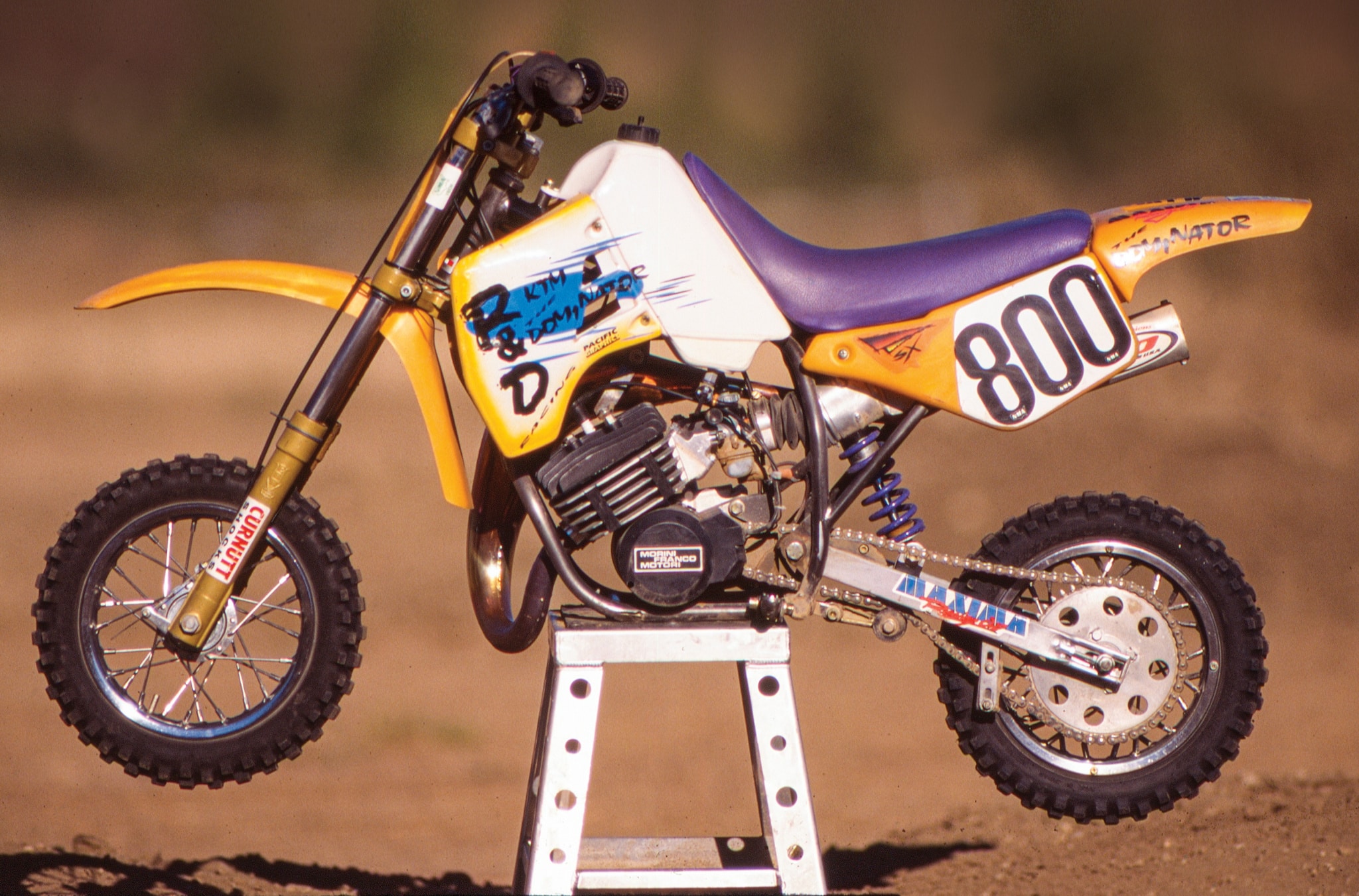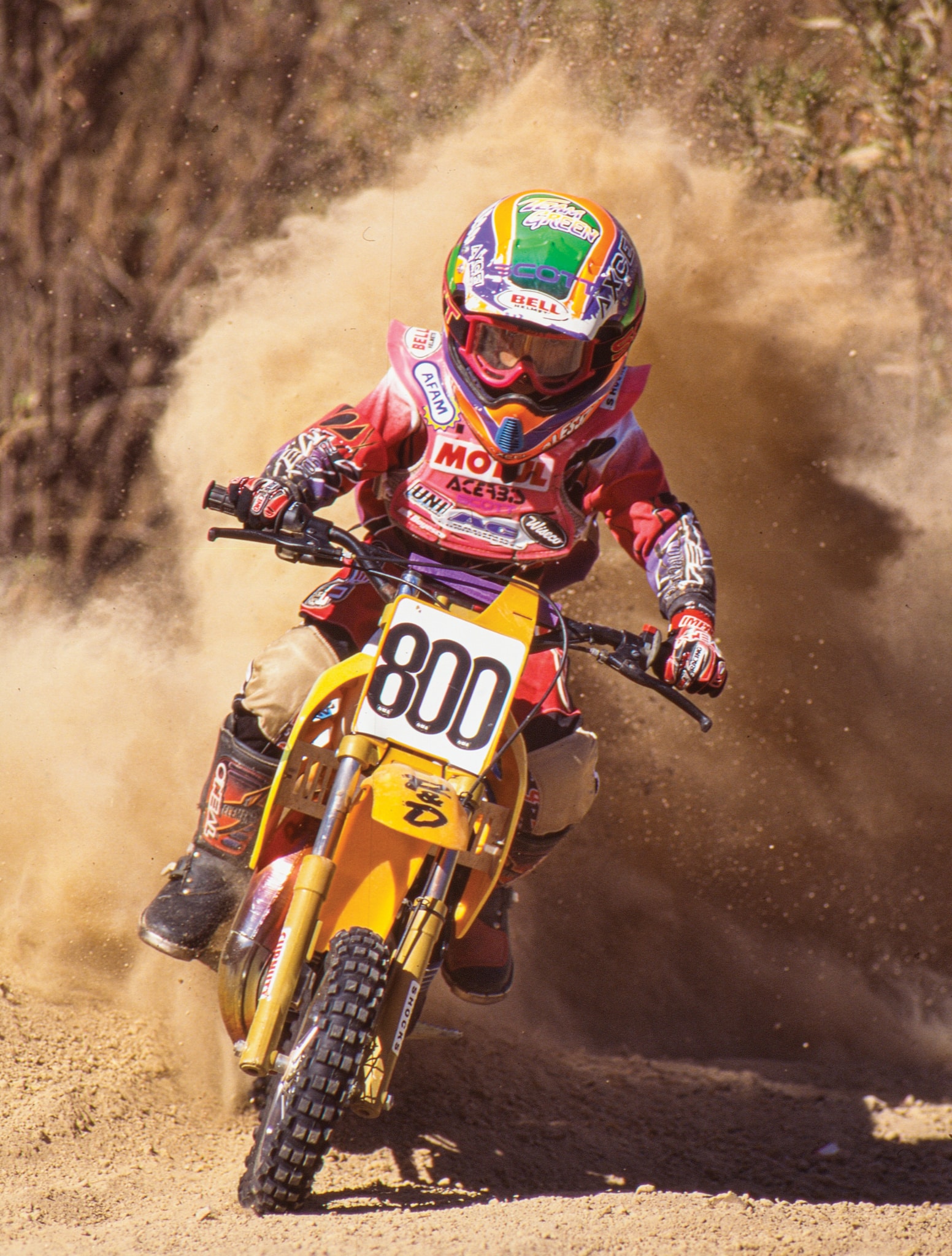MXA RETRO TEST: WE TEST MIKE ALESSI’S WORLD CHAMPIONSHIP R&D KTM 50

We get misty-eyed sometimes thinking about past bikes we loved and those that should remain forgotten. We want to take you on a trip down memory lane with bike tests that got filed away and disregarded in the MXA archives. We love to reminisce on a piece of moto history that has been resurrected. Here is the test we did on Mike Alessi’s 1996 National Championship R&D KTM 50.
All eyes focused on World Pee-Wee Champion Mike Alessi as he idled his KTM 50 onto the Ponca City start pad. Not a word was spoken as the little Katoom shot out of the hole, spewing dirt all the way to the first turn. After sailing completely over the bridge tabletop, the 7-year-old continued on to wheelie down straights and rail turns as he worked the micro KTM around the track. From that moment on, Alessi’s R&D KTM 50 was larger than life.
“That ain’t no 50,” said a disgruntled father. “Listen, it sounds like the plates are being slipped out of the corners,” commented another competitor’s father. “That kid could win the 60 class on that bike,” said a flagman. “That thing is a cheater,” complained an 80cc rider’s mother. Rarely does a Pee-Wee garner as much attention as the bike that Mike Alessi used to dominate the NMA-sponsored Ponca City National Amateur Championships.

IN PURSUIT OF PERFECT PERFORMANCE
“We have plenty of experience with the Moto-Morini engine that KTM uses in its 50s,” said R&D’s Dean Dickerson. “Since our experience dates back to 1972 with Indians and Italjets, we can rightfully claim knowledge about every nuance in design. But, that didn’t stop us from looking for new and innovative ways to extract even more power from the Moto-Morini.
“But that’s only half the story,” continues Dean. “In order to build a unified bike, it was necessary to match the quadrupled horsepower engine to the chassis. The result is awesome, to say the least.”
ENGINE THAT DOMINATES
R&D’s Dominator engine kit increases the stock KTM’s 2.5 horsepower to a solid 10 horsepower. The power is delivered across the widest possible range to best accommodate the single-speed, centrifugal clutch drivetrain. Almost every aspect of the KTM 50 engine is modified in the Dominator kit.
Cylinder: R&D starts with a 1997 KTM 50SX3 cylinder (with more port area and a four-petal reed cage). How does it get away with a pre-production cylinder? The production rule does not apply to the NMA Super Pee-Wee class.
Dominator porting: NMA rules allow for a 61cc displacement limit in the Super Pee-Wee division. R&D bores the cylinder and Nikasils it to run a modified KX60 piston with a final displacement of 60.4cc. R&D tunes the ports and re-chambers the head for steady power. Machining the cylinder allows the use of an O-ring head gasket. The compression ratio is upped from 7.5:l to 9.0:1.
Spark plug: While the standard KTM 50 comes with a hot, 4-heat-range plug, the Dominator engine is tuned to use a more conventional 7 or 8 plug.
Pipe: The Dominator exhaust system features a rebuildable, oval aluminum muffler; rubber-mounted pipe attachments; and custom aluminum manifold with a dual O-ring seal.
Carburetor: A special manifold holds an 18mm round-slide Mikuni (a 12mm Dell’Orto is standard). Single-stage carbon fiber R&D reeds are used with a preproduction 1997 cage that has been matched to the R&D manifold.
Airbox: An AC aluminum airbox allows increased airflow and room for more wheel travel.
Crank: The stock lower rod pin-to-crank-wheel engagement is marginal and easily twists out of adjustment. R&D welds the pin to the crank halves.
Dominator clutch system: A highly tunable centrifugal disc clutch replaces the standard shoe-type unit. The stock clutch engages (stall speed) abruptly at 2500 rpm, resulting in a severe sag in power delivery. R&D tuned Alessi’s clutch to start slipping at 4000 rpm and to totally lock in at 8000 rpm. The R&D clutch will slip as necessary under load and automatically bring revs back up to the peak again. The smaller assembly also reduces rotating mass for snappier, smoother power delivery.
Gearing: Alessi runs 11/45 gearing (11/50 is stock) with AFAM sprockets and a Tsubaki 415 road race chain.

CHASSIS MODIFICATIONS
Swingarm pivot bolt: KTM does not use an inner spacer between the two outboard bushing sleeves in the swingarm pivot. This keeps the swingarm bolt from being tightened sufficiently and, consequently, allows the loose axle to wallow out of the frame mounts. R&D manufactures an inner spacer that allows the pivot bolt to clamp solid.
Rear-wheel axle adjusters: The rear axle slides into the open ends of the swingarm, which flares open when the axle is tightened hard. R&D closes the end of the axle plates and then drills the swingarm to run a push-bolt axle adjustment system.
Rear axle: The stock axle bends easily. Alessi’s bike runs a modified, hand-me-down, George Holland, heat-treated chromoly axle from when R&D sponsored George on an RM80.
Head stay: Heavier-gauge chromoly steel replaces the stock head stay that is prone to cracking.
Air scoop: AC Racing provides the tank-shroud assembly that effectively replaces the stock, breakage-prone, plastic support between the tank scoop and the frame.
Wheels: Mike Alessi breaks the production 10-inch cast-aluminum wheels. Replacements were laced using Suzuki JR50 rims, Buchanon spokes, standard SX Pro rear hub and a custom-machined billet-aluminum front hub. Dunlop 752s (2.50×10) are used on both ends. Air pressure is kept in the l5- to 18-psi range.
LONG-TRAVEL SUSPENSION
Fork: Curnutt modifies the 28mm EBR legs to provide an inch more fork travel. Billet-aluminum damper rods offer a sealed fit at the head and use an orifice-style valving system. Five coils are removed to stiffen the stock fork springs, and 5W oil is used (20W oil is stock).
Handlebar: KTM’s stock handlebars are dimpled to allow the fork tubes to be slid up in the clamps (this is only applicable to the new aluminum clamps with a more forward bar position). Alessi drops the front end 2 inches to balance the bike and lessen the leverage on the stanchion tubes (they bend).
Shock: The Curnutt gas-emulsion shock features position-sensitive valving, which adds a progressive feel to the non-linkage system. A straight-rate, 175-pound KX60 shock spring is used. Rear-wheel travel is increased from 7.75 inches to a whopping 10 inches.
THE RESULTS
The results speak for themselves. The R&D KTM 50 is rapidly becoming to Pee-Wee racing what Jeremy McGrath’s CR250 is to Supercross.







Comments are closed.